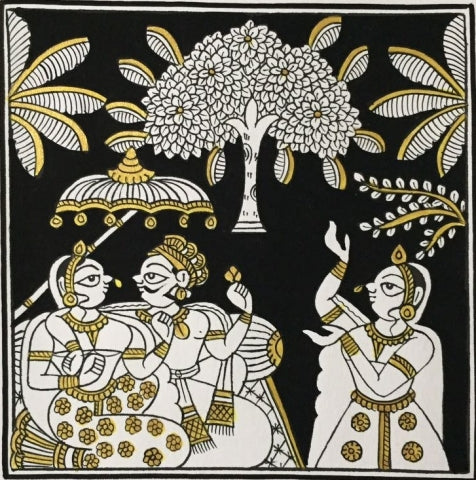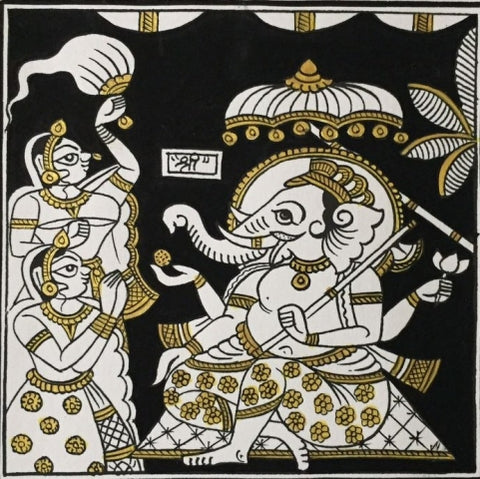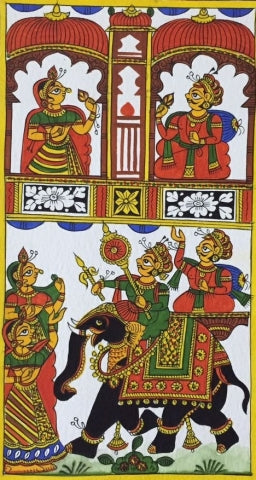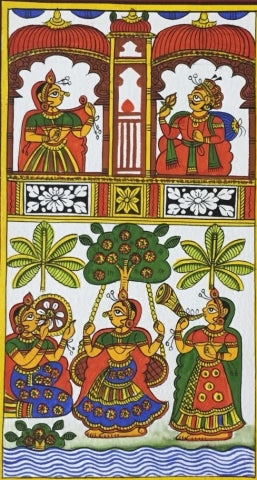India has a rich and vibrant cultural heritage. The important part is that we the people of India have still kept that culture alive. We still can witness our ancient cultural influences in our modern routine. We treasure our heritage with pride. Paintings are also a big part of our culture. There are myriad painting styles that find their roots in India and have stories attached to them. One such painting style is Phad painting. Phad is an indigenous painting style of the state of Rajasthan, India, that depicts the narratives of the folk deities of the state. This style of painting is the blend of Rajput and Mughal styles of painting. Originated thousands of years ago, this fabled heritage of Bhilwara is done on a long piece of canvas called Phad. Mostly, the stories of the folk deity Pabuji and the Gurjar Warrior, Devnarayanji are depicted on Phads. In ancient times, the storytellers would travel from village to village and narrate the stories using Phads as their pictorial depiction tool. Singing and dancing made an integral part of storytelling. The priest singers and dancers of Rajasthan known as Bhopas and Bhopis would carry the painted Phad scrolls along to use them as a part of their elaborate song and dance performances to narrate the lores of the folk deities who are worshiped in that region. The Bhopa had a musical instrument known as Ravanahatha. Accompanying him was his wife Bhopi who would sing and dance on the tune along with reciting the poetry and narrate the stories of the glory of folk deities. This whole would turn out to be an entertaining event for the village residents that would go on overnight. We can still witness this in some villages of India.
Technique
Phad paintings are very detailed. Every inch of the canvas is used. Since the ancient stories are depicted in the paintings, Phads have a lot of human figures in them. The size and color of which depends upon the role and position they had. These paintings are done on clothes. A thick fine paste of wheat/rice flour, prepared by boiling the mixture in water, is applied on the cloth which is then dried in sunlight. The cloth is then rubbed with Mohra (a stone device) to bring out the smoothness and shine in it. Now the cloth is ready to be painted. The colors used in Phad are all-natural, obtained from various plants and vegetable extracts. Earthen colors are used to bring the acrylic effect.


Taking the legacy forward
The Joshi Family of Bhilwara exclusively practiced Phad for centuries. Up until 50 years ago they were authorized by the Bhopas and Bhopis to make the Phads and were very particular about not missing out on the authenticity of the techniques of the artwork. However, witnessing the gradual fading of the art form, Shree Lal Joshi, Padma Shree recipient and one of the most renowned Phad artist, decided to lay the foundation of a school that teaches this mythical art form. Henceforth, Joshi Kala Kunj got established in 1960. The school which now has been renamed to Chitrashala teaches the Phad without compromising on the originality of the techniques of the art form. Till date, thousands of students have learned Phad painting from this school. Shree lal Joshi's son Kalyan Joshi, the 30th generation member of Joshi family also learned the art form from his father and started practicing at an early age. He is now an established Phad artist and keeps promoting the artform and aims to keep it alive forever. In one of his talk sessions, Kalyan Joshi opened up about his thought behind painting stories other than Pabuji and Devnarayanji. He highlighted that there are various other fascinating stories that people find interesting like Ramayana, Mahabharat, Geet Govind, and the likes. He has even painted Panchatantra stories, some of which are now a part of children's textbooks. Pradip Mukherjee, another very prominent person in Phad practice and the student of Shree Lal Joshi, also has a very important role in taking the heritage forward. Knowing the fact that the Phads of Pabuji and Devnarayan were the only source of livelihood for the Joshi family, he decided not to paint the same and rather opted to paint the tales from Hindu mythology. He painted a series of 108 Phads on Ramcharitmanas between 1980 and 1982.



Phad in Modern times
Nowadays these paintings are made by introducing new themes but at the same time make sure that the original techniques are not hindered. Also, makers are now not commissioned by the Bhopas and Bhopis to make the Phads. They have started depicting simple scenes like Hindu marriage proceedings. The Phad that used to be approximately 30 feet long has now trimmed down to approximately 2-3 feet in length. Since Bhopas and Bhopis used to narrate the stories in regional dialect, Kalyan Joshi, with the help of a research scholar from Pennsylvania University has also made animated Phads. Adding different sound effects and dubbing them in different languages they have made animated movies using Phads so that they can be understood by people of all languages and regions.









